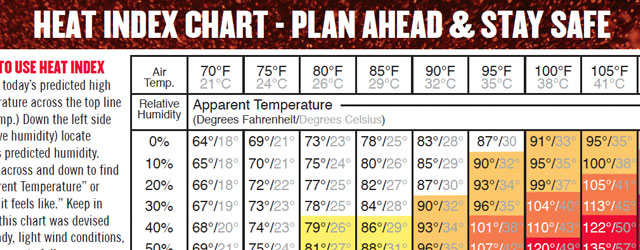How Does Heat Index Work? Stay Safe

The heat index, also known as the apparent temperature, is a measure of how hot it actually feels outside when the temperature and humidity are combined. It’s a crucial factor to consider, especially during the sweltering summer months, as it can greatly impact our comfort and safety. But have you ever wondered how the heat index works and why it’s so important to stay informed about it?
To understand the heat index, let’s dive into the science behind it. The heat index is calculated using a formula that takes into account the air temperature and the relative humidity. The National Weather Service (NWS) uses the following formula to calculate the heat index:
HI = c1 + c2T + c3R + c4TR + c5T^2 + c6R^2 + c7T^2R + c8TR^2 + c9T^2R^2
where: - HI = heat index (°F) - T = air temperature (°F) - R = relative humidity (%) - c1-c9 = constants
While this formula may look complex, it essentially boils down to this: when the air temperature and humidity are high, the heat index increases, indicating that it feels hotter than the actual air temperature.
But why does the heat index matter? The answer lies in its impact on our bodies. When the heat index is high, our bodies have a harder time cooling themselves, which can lead to heat-related illnesses like heat exhaustion and heat stroke. These conditions can be serious and even life-threatening, especially for vulnerable populations like the elderly, young children, and people with certain medical conditions.
So, how can you stay safe during periods of high heat index? Here are some tips:
- Stay hydrated: Drink plenty of water and other fluids to help your body regulate its temperature. Avoid sugary and caffeinated drinks, as they can exacerbate dehydration.
- Take breaks: If you must be outside, take regular breaks in cool, shady areas to give your body a chance to recover.
- Dress for success: Wear lightweight, light-colored clothing that allows for good airflow and helps to keep you cool.
- Avoid strenuous activity: Try to avoid engaging in strenuous activities during the hottest part of the day (usually between 11am and 3pm).
- Monitor the weather: Keep an eye on the weather forecast and sign up for heat alerts from your local weather service to stay informed about heat index levels.
Beat the Heat: A Step-by-Step Guide
- Check the forecast: Before heading outside, check the weather forecast to see if there are any heat alerts or advisories in your area.
- Plan your day: Adjust your schedule to avoid being outside during the hottest part of the day.
- Stay cool: Wear cool, lightweight clothing and stay hydrated by drinking plenty of water.
- Take breaks: Take regular breaks in cool, shady areas to give your body a chance to recover.
- Seek medical attention: If you or someone you know is experiencing symptoms of heat-related illness, seek medical attention immediately.
In addition to these tips, it’s also important to be aware of the signs and symptoms of heat-related illnesses. These can include:
- Heavy sweating
- Pale or cool skin
- Fast or weak pulse
- Nausea or vomiting
- Dizziness or fainting
If you or someone you know is experiencing any of these symptoms, seek medical attention immediately.
What is the difference between heat exhaustion and heat stroke?
+Heat exhaustion is a milder condition that can develop after spending time in the heat. Symptoms include heavy sweating, pale or cool skin, and a fast or weak pulse. Heat stroke, on the other hand, is a more serious condition that occurs when the body's temperature regulation fails. Symptoms include a body temperature of 103°F or higher, confusion, and seizures.
How can I stay cool when I don't have access to air conditioning?
+There are several ways to stay cool without air conditioning. These include using fans, taking cool showers or baths, and staying in cool, shady areas. You can also use cooling packs or cold compresses to help lower your body temperature.
What are some common mistakes people make when trying to stay cool in the heat?
+Common mistakes people make when trying to stay cool in the heat include not drinking enough water, wearing dark or heavy clothing, and engaging in strenuous activity during the hottest part of the day. It's also important to avoid leaving children or pets in cars, as this can quickly lead to heat-related illness.
In conclusion, the heat index is a critical factor to consider during the summer months, as it can have a significant impact on our comfort and safety. By understanding how the heat index works and taking steps to stay cool and hydrated, we can reduce our risk of heat-related illnesses and stay safe. Remember to stay informed about heat index levels in your area, and take precautions to protect yourself and your loved ones from the heat.


